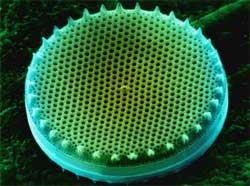Diatoms -- some of which are so tiny that 30 can fit across the width of a human hair -- are so numerous that they are among the key organisms taking the greenhouse gas carbon dioxide out of the Earth's atmosphere.
The shells of diatoms are so heavy that when they die in the oceans they typically sink to watery graves on the seafloor, taking carbon out of the surface waters and locking it into sediments below.
Scientists have reported the discovery of whole subsets of genes and proteins that govern how one species of diatom builds its shell. For oceanographers, the work might one day help them understand how thousands of different kinds of diatoms -- and their ability to remove carbon dioxide from the atmosphere -- might be affected by something like global climate change. Material scientists involved in the work are interested in the possibilities of manipulating the genes responsible for silica production as a way of fabricating more efficient computer chips.
Diatoms, most of which are far too tiny to see without magnification, are incredibly important in the global carbon cycle, says Thomas Mock, a University of Washington postdoctoral researcher in oceanography and lead author of the paper. During photosynthesis, diatoms turn carbon dioxide into organic carbon and, in the process, generate oxygen. They are responsible for 40 percent of the organic carbon produced in the world's oceans each year.
The new work took advantage of the genomic map of the diatom Thalassiosira pseudonana published in 2004 by a team led by UW oceanography professor Virginia Armbrust, who is corresponding author of the new PNAS paper.* Thalassiosira pseudonana is encased in a hatbox-shaped shell comprised of a rigid cell wall, made mainly of silica and delicately marked with pores in patterns distinctive enough for scientists to tell it from other diatoms.
Armed with the genomic map, the researchers changed environmental conditions in laboratory cultures of Thalassiosira pseudonana, for example limiting the amount of silicon and changing the temperatures. Then researchers used what's called "whole genome expression profiling" to determine which parts of the genome were triggered to compensate.

